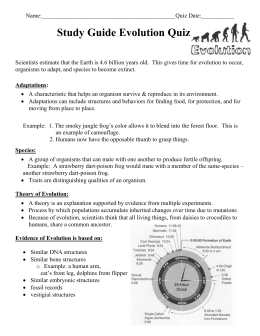Evidence For Evolution Test Study Guide
Who's It For? Anyone who needs help understanding evolution material will benefit from taking this course. You will be able to grasp the subject matter faster, retain critical knowledge longer and earn better grades. You're in the right place if you:. Have fallen behind in understanding random mutation, genetic variability, punctuated equilibrium, the structure of chromosomes, or any other evolution topic. Need an efficient way to learn science.
Learn best with engaging auditory and visual tools. Struggle with learning disabilities or learning differences, including autism and ADHD. Experience difficulty understanding your teachers.
Missed class time and need to catch up. Can't access extra science learning resources at school.
Natural Selection & Evolution How Evolution Works The theory of evolution is a governing paradigm in Biology. Evolution refers to a change in the descendants of living systems at the genetic or hereditary level. Typically, evolution does not take place during the lifetime of an organism.
Instead, traits (genes) are passed down from generation to generation. The major driving force behind evolution is natural selection. Natural selection is the gradual process by which traits are either eliminated or become more common in a population over time. In addition to natural selection, another common theme studied with evolution is common descent with modification.
Common descent with modification explains how new species are formed in a process referred to as speciation. It suggests that all living things on earth have a common ancestor, and that the changes in the genetic makeup of ancestral descendants over time led to the wide range of species that are present on earth. To explain how these changes take place, the principle of natural selection is used The Evidence for Evolution In natural selection, favorable traits are selected from generation to generation. These traits must confer a reproductive advantage to the members of the population, in order for them to become more common. The ability of bacteria to develop resistance to antibiotics is an example of natural selection. Prior to exposure to the antibiotic, the population of bacterial cells contains a mixture of individuals with different degrees of resistance to the drug. After exposure, selection takes place and only the bacteria that are resistant to the drug survive.
Over time, these resistant individuals reproduce with one another to create a population of bacteria that contains a majority if not exclusive number of resistant individuals. This demonstrates that the selection or selection pressure is influenced by the environment. It is also important to notice that natural selection takes place at the level of the phenotype (what you see) and not the genotype (the genetic makeup).
The individuals in the population choose mates based on features that are visible or noticeable. This of course affects the genotype of the offspring What is Natural Selection Natural Selection takes place in three different patterns, based on the species and the selection pressures that are involved.
The three patterns are directional selection, stabilizing selection, and disruptive selection. In stabilizing selection, the intermediate phenotypes of the offspring are favored while extreme phenotypes are eliminated. An example of stabilizing selection at work is observed with the birth weight of infants. Infant deaths are highest among infants with low and high birth weights, while they are lowest among infants that have average birth weights. In directional selection, an extreme phenotype is favored. An example of directional selection is the increase in the size of the human skull over time.
If the skulls of earlier species of man are compared in chronological order ending with Homo sapiens, a constant increase in the cranial capacity of the skull is observed. In disruptive selection, two extreme phenotypes are favored in the population, while the intermediate phenotype is driven towards elimination.

Biology Evolution Test
If there is a mixed population of butterflies with red, white, and pink individuals and over time the pink individuals are eliminated, then disruptive selection has taken place. In such a population, only extremes - white and red - are present.